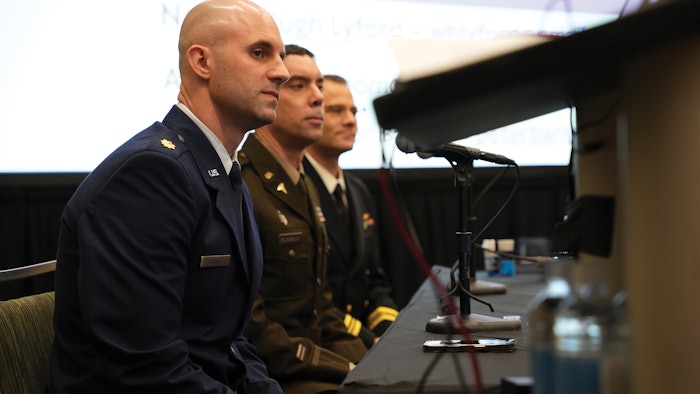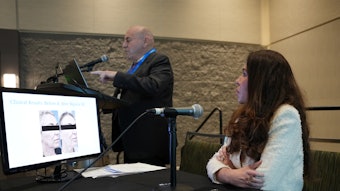Serving those who serve
Civilian dermatology aids the care of military service members, veterans, and their families.

Dermatology is committed to addressing the needs of those who serve our country. As the number of U.S. military active-duty dermatologists dwindles due to recent policy changes, civilian dermatologists are doing their part to address and assist the specialized needs of members of the military and their families.
During Saturday’s session, U040 – Dermatology on Duty: Managing Active-Duty Military Members in Your Practice, Willis Hugh Lyford, MD, FAAD, led an inspiring discussion on current dermatologic concerns within this large population of U.S. military service members and their families. Dr. Lyford is an active-duty dermatologist stationed at Naval Medical Center San Diego, where he holds an assistant professorship of dermatology. He is also an adjunct professor of dermatology at the Uniformed Services University of the Health Sciences in Bethesda, Maryland.
 Willis Hugh Lyford, MD, FAAD
Willis Hugh Lyford, MD, FAAD
Although recent legislation has taken steps to curtail the 2017 National Defense Authorization Act reduction, there is still a shortage of active-duty dermatologists. As a result, a growing number of military members and their families are seeing civilian dermatologists who must manage their often-unique medical care while keeping in mind their military status.
Factors affecting care
During the session, Dr. Lyford was joined by two experts in the field: Luke R. Bloomquist, MD, FAAD, and Peter Barnes, MD, FAAD. The panel addressed many factors that play a role in an active-duty military service member’s health care, including:
- Deployment or Permanent Change of Station (PCS), where someone is ordered to move across country or even overseas
- Access to specialty clinics
- Presence of dermatologic conditions that can be exacerbated by service-related work or deployment
“Members and their families can have unique needs reflective of their military duties, their deployment status, and access to medications or treatments in austere or overseas environments,” Dr. Lyford said. “Family members’ medical conditions can impact an entire family’s ability to move frequently or live overseas. As a result, it is important for all our colleagues outside the military to be aware of how the treatment they render can impact a service member’s career to provide holistic care.”
The session was designed to equip civilian dermatologists with the knowledge and confidence to work with all members of the military who are referred to their clinic and to offer them care that takes their extraordinary work and life circumstances into account, Dr. Lyford said.
Have you seen this?
Some dermatologic conditions that arise or are worsened from deployment may be first-time experiences for the civilian dermatologists. Similarly, there may be common conditions that present differently due to the nature of a military service member’s job. For example, military grooming standards make conditions like pseudofolliculitis barbae, acne keloidalis nuchae, and traction alopecia more common, Dr. Lyford said. Additionally, certain work environments may expose members to unique contact allergens, which may not be elucidated on a standard contact allergen panel, he added.
Dr. Lyford discussed the high-yield topics dermatologists must understand to effectively manage service members and their dermatologic conditions. This included dialogues on treating service members with biologics or immunomodulators, pathways to obtain prior authorization approval, and each service branch’s policy on biologics and assignment to special duty, deployability, and overseas duty assignments.
Dr. Bloomquist, who is stationed in Germany, emphasized the increased skin cancer risk service members and veterans carry due to their line of work. Receiving news of skin cancer can be very scary for anyone, but especially if it impacts your livelihood. Consider, he said, a patient starting out in the service or one who is nearing retirement and being concerned the diagnosis may prevent them from serving.
It is also critical, Dr. Bloomquist said, to prescribe specific limitations to service members following procedures, as they have strong work ethics and are not inclined to limit themselves.
Cutting through red tape
It’s important to note, Dr. Lyford said, that U.S. Department of Defense (DOD) policy continues to evolve to better suit the needs of the respective service branches and balance the needs of service members with changes in our understanding of disease etiologies and pathogenesis and changes taking place in our society.
As civilian dermatologists come to treat more service members, they’ll need to grasp the intricacies of DOD policy to ensure that their care will not inadvertently impact a member’s ability to perform their work duties.
“Our goal is for clinical dermatologists to better understand the special circumstances soldiers, sailors, and airmen bring with them when they visit their office and ways that we, as their dermatologists, can more easily navigate their TRICARE health care network, interface with clinicians within the U.S. Department of Defense for consultations and follow-up care, and effectively start and manage therapies,” said Dr. Lyford.











